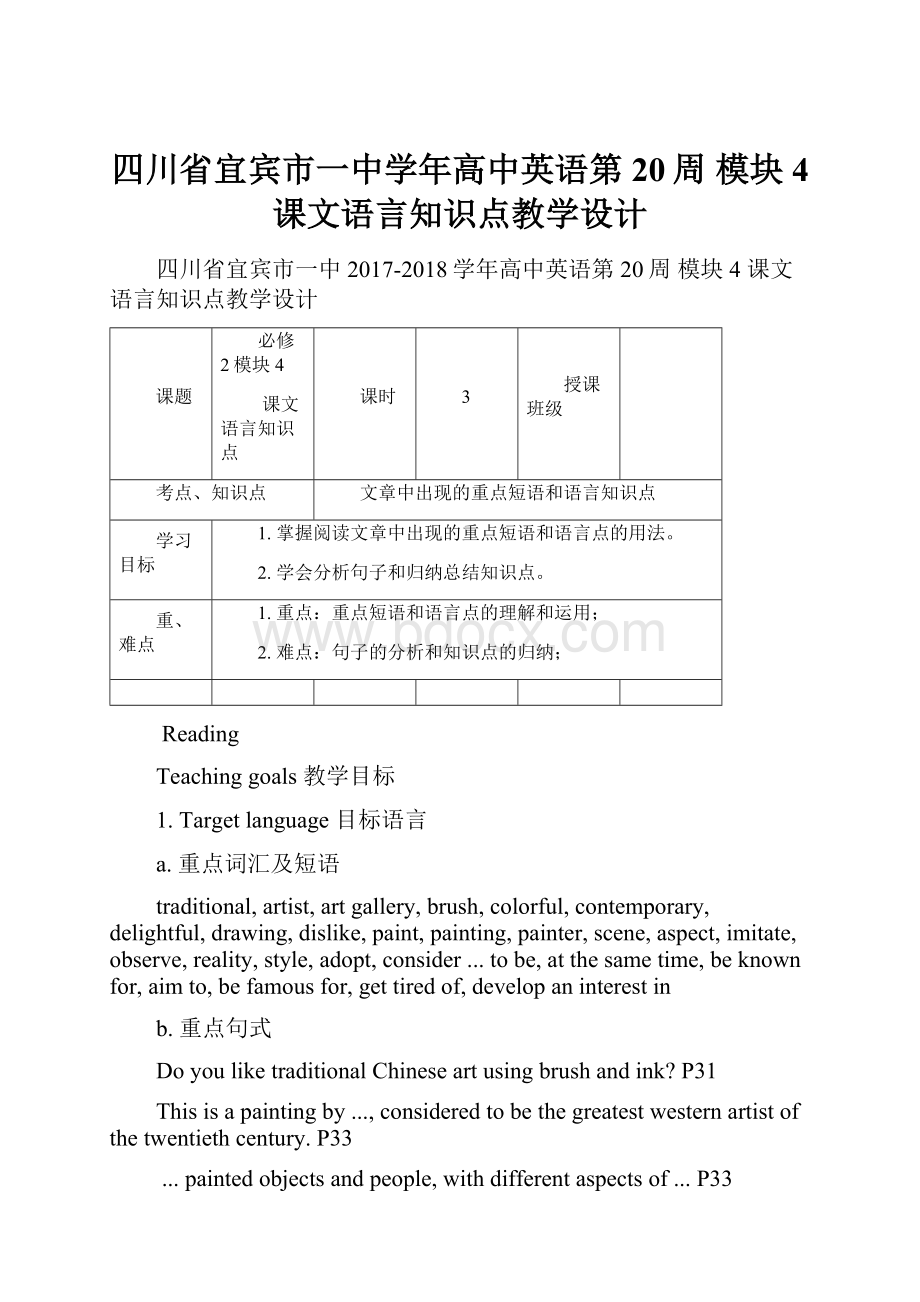四川省宜宾市一中学年高中英语第20周 模块4 课文语言知识点教学设计.docx
《四川省宜宾市一中学年高中英语第20周 模块4 课文语言知识点教学设计.docx》由会员分享,可在线阅读,更多相关《四川省宜宾市一中学年高中英语第20周 模块4 课文语言知识点教学设计.docx(13页珍藏版)》请在冰豆网上搜索。

四川省宜宾市一中学年高中英语第20周模块4课文语言知识点教学设计
四川省宜宾市一中2017-2018学年高中英语第20周模块4课文语言知识点教学设计
课题
必修2模块4
课文语言知识点
课时
3
授课班级
考点、知识点
文章中出现的重点短语和语言知识点
学习目标
1.掌握阅读文章中出现的重点短语和语言点的用法。
2.学会分析句子和归纳总结知识点。
重、难点
1.重点:
重点短语和语言点的理解和运用;
2.难点:
句子的分析和知识点的归纳;
Reading
Teachinggoals教学目标
1.Targetlanguage目标语言
a.重点词汇及短语
traditional,artist,artgallery,brush,colorful,contemporary,delightful,drawing,dislike,paint,painting,painter,scene,aspect,imitate,observe,reality,style,adopt,consider...tobe,atthesametime,beknownfor,aimto,befamousfor,gettiredof,developaninterestin
b.重点句式
DoyouliketraditionalChineseartusingbrushandink?
P31
Thisisapaintingby...,consideredtobethegreatestwesternartistofthetwentiethcentury.P33
...paintedobjectsandpeople,withdifferentaspectsof...P33
Chinesepaintingisknownforitsbrushdrawingsinblackinksandnaturalcolours.P33
Icantellbythestyle.P33
2.Abilitygoals能力目标
Enablethestudentstotalkaboutsomeworld-classartistsandtheirstyles.
3.Learningabilitygoals学能目标
Helpthestudentslearnhowtotalkaboutfamousartistsandtheirstyles.
Teachingimportantpoints教学重点
Helpthestudentstalkaboutsomefamousartistsandtheirarts.
Teachingdifficultpoints教学难点
Letthestudentsdiscusstheworldfamousartistsandtheirpaintings.
Teachingmethods教学方法
Discussingandlistening.
Teachingaids教具准备
Acomputerandarecorder.
Teachingprocedures&ways教学过程与方式
StepILead-in
T:
Youhavebeeninthisclassroomforalongtime.Haveyouevernoticedthehandwritingsandpicturesbysomefamousartistshungonthewall?
Ss:
Yes,wehavenoticedthem.
T:
Thendoyoulikethem?
Ss:
Yes,welikethemverymuch.
T:
FromthisIcanseethatyouareinterestedinart.Wouldyouliketotellmethereasonwhyyoulikeart?
Ss:
Becauseartcanbringuspleasure,tellusviewsandattitudestowardslifeandmakeusthinkalotaboutlife.
T:
Good.Thencanyounameagreatnineteenth-centuryChineseartist?
S:
QiBaishi.HewasoneofChina’sgreatestpainters,whofollowedthetraditionalChinesestyleofpainting.
S:
XuBeihong,whoismostfamousforhislivelypaintingsofhorses.
T:
Excellent.DoyouliketraditionalChineseartusingbrushandink?
Ss:
Yes.Wealllikeit.
T:
OK!
StepIIPre-reading
T:
Now,lookatthethreepicturesandanswerthefollowingquestions.
Showthequestionsonthescreen.
1.Whichonedoyouprefer?
2.Whopaintedthem?
3.Whatdoyouthinkaboutit?
Allowthemenoughtimetoprepare.
T:
Haveyoufinished?
Volunteer?
S:
ThepictureIlikebestisPicture3.It’sbyQiBaishi,oneofChina’sgreatestpainters.Itshowstwooxenarewalkingonthebankoftheriverwithtreesaround.ItisalivelypaintinginthetraditionalChinesestyle.Inthepicture,thetwooxenlookperfectlyrelaxed.
S:
IpreferPicture2.Maybeit’sbyaChineseartist.Thisisaverybeautifulwatercolor.Inthepicturewecanseegreentreeshereandthere,astreamrunningquietlyandhighmountainsinthedistance.Amongthetreesareafewhouses.Howpeacefulitlooks!
S:
IlikePicture1best.It’sbyPicasso,oneofthegreatestwesternartists.ItsnameisBeSentencedtoDeath.Itshowsapoorwomanwhowassentencedtodeathsittingthereverysadly.Themaincolorwasblue.Inthispainting,Picassoshowedthelifeofpoorunhappypeople.
StepIIIReading
Task1Fastreading
T:
Youcanseefourbeautifulpaintings.Ontherightofthemaresixshortpassages,whichtellsomethingaboutthepaintings.Iallowyoufiveminutestoreadtheparagraphs.Thenmatchpaintings1-4withdescriptionsinparagraphsA-D.
Fiveminuteslater.
T:
Areyouready?
Who’dliketotellustheanswers?
S:
Yes.IthinkPicture1isbyQiBaishi,whoisgoodatbrushpaintingsinblackinksandnaturalcolours.SoParagraphCdescribesPicture1.
T:
Good.Next?
S:
IthinkPicture2isbyPicasso,whoisgoodatpaintingpicturesinblue.Furthermore,Picassooftenshowedhissympathytowardspoorandunhappypeople.SoParagraphAdescribesPicture2.
T:
Youareright.WhataboutPicture3?
S:
IthinkPicture3istheSixHorsespaintedbyXuBeihongin1925.Itshowssixhorsesarerunningtowardsus.ItisalivelypaintinginthetraditionalChinesestyle.SoPicture3matchesParagraphD.
T:
Excellent.Thelastpicture?
S:
Picture4isbyafamousAmericanartistnamedRoyLichtenstein.SoPicture4matchesParagraphB.
T:
Doyouagreewithhim/her?
Ss:
Yes.
T:
Good.NowreadthepassagesagainandsaywhichpaintingsarementionedinParagraphsEandF.
S:
InParagraphE,WuHangsaidhewascrazyaboutthepaintingsofQiBaishiandcouldn’tstandthepictureofagolden-hairedgirl.Therefore,hementionedPictures1and4.
S:
InParagraphF,SarahHardwicktalkedaboutthepictureofthesixhorsesandthepictureoftheyounggirlbyPicasso.SoshementionedPictures2and3.
Task2Detailedreading
Thisstepisdesignedtohelpthestudentsunderstandthepassagefurther.AskthestudentstoreadParagraphsA-Fcarefullyandanswerthefollowingquestionsinpairs.AtlastaskthemtochoosethecorrectanswertoActivity3.
T:
Now,pleasereadthepassagescarefullyandanswerthequestionsonthescreen.
1.What’sQiBaishi’sstyleofpainting?
2.What’sXuBeihong’sopinionofpainting?
3.What’sXuBeihongfamousfor?
4.Whatdoes“popart”mean?
5.WhichpicturesdoesWuHanglikeandwhichonedoeshedislike?
6.WhichpicturesdoesSarahHardwicklove?
Afterafewminutes.
T:
NowI’msurethatyouhavefinishedreading.Let’saskandanswerthequestionsinpairs.Who’dliketotry?
S:
What’sQiBaishi’sstyleofpainting?
S:
HefollowedthetraditionalChinesestyleofpainting.
S:
What’sXuBeihong’sopinionofpainting?
S:
Hebelievedthatartistsshouldshowreality,butnotjustimitateitandthatapictureshouldtrytoshowthe“life”ofitssubject.
S:
What’sXuBeihongfamousfor?
S:
Heismostfamousforhislivelypaintingsofhorses.
S:
Whatdoes“popart”mean?
S:
Popartwasanimportantmodernartmovementthataimedtoshowordinarytwentieth-centurycitylife.
S:
WhichpicturesdoesWuHanglikeandwhichonedoeshedislike?
S:
HelikesthepaintingsofQiBaishianddislikesthepictureofagolden-hairedgirl.
S:
WhichpicturesdoesSarahHardwicklove?
S:
Shelovesthepictureofthesixhorsesandthepaintingoftheyounggirl.
ChoosethecorrectanswertoActivity3.
T:
Good!
Youallhavedoneagoodjob.Let’sdoActivity3.
Afewminuteslater.
T:
Areyouready?
Let’shaveacheck.Who’dliketotellustheanswers?
Task3Languagepoints
Thisstepistohelpthestudentsunderstandthetext,buildtheirvocabularyandimprovetheirabilitiestoputwhattheyhavelearnedintopractice.
T:
Let’slookatthescreen.I’llexplainsomelanguagepointstoyou.
Showsomelanguagepointsonthescreen.
1.DoyouliketraditionalChineseartusingbrushandink?
“...usingbrushandink”means“whichusesbrushandink”.
2.ThisisapaintingbytheSpanishartist,PabloPicasso,consideredtobethegreatestwesternartistofthetwentiethcentury.
Thepartunderlinedmeans:
whoisconsideredtobethegreatestwesternartistofthetwentiethcentury.
e.g.Einsteinwasconsideredtobe/asoneofthegreatestscientists.
3.Cubistartistspaintedobjectsandpeople,withdifferentaspectsoftheobjectorpersonshowingatthesametime.
Payattentiontothestructure“with+n./pron.+objectcomplement”
e.g.Withsomuchworktodo,hewasverybusy.
Withtheboyleadingtheroad,wehadnodifficultyfindinghishouse.
4.Chinesepaintingisknownforitsbrushdrawingsinblackinksandnaturalcolors.
“beknownfor”:
befamousfor
5.Instead,apictureshouldtrytoshowthe“life”ofitssubject.
e.g.Hedidn’tgothere.Instead,hestayedathomeandthoughtalotaboutthematter.
Igotoschoolbybikeinsteadofbus.
6.I’mstudyingartatschool,andIenjoyitalot,althoughIcangettiredoflookingatpicturesallthetime.
“gettiredof”:
getfedupwith
7.ButIcan’tstandthatpictureofagolden-hairedgirl.
e.g.Hecan’tstandbeingmadefunof.
Payattentiontothewordformationhere.
e.g.four-legged,red-eyed...
8.Heismostfamousforhislivelypaintingsofhorses.
“most”:
very.
e.g.Thankyouverymuch.Youaremostkind.
9.Imustsay,Ilovethatpictureofthesixhorses.
“Imustsay”:
inmyopinion
10.ThisisapaintingbytheSpanishartist,PabloPicasso,consideredtobethegreatestwesternartistofthetwentiethcentury.(P33)
【分析】
①本句是一个简单句。
②句子的主干是“主语(This)+系动词(is)+表语(apainting)”结构。
③bytheSpanishartist是介词短语作后置定语,修饰painting;PabloPicasso是Spanishartist的同位语。
④consideredtobe...century是动词-ed形式作后置定语,修饰PabloPicasso。
【句意】这是西班牙画家巴勃罗·毕加索的一幅油画,他被认为是20世纪西方最伟大的画家。
11.Myparentsarefondofgoingtoartgalleriesandoftentakemewiththem,soI’vedevelopedaninterestinart. (P33)
【分析】
①本句是一个由so连接的并列句。
②so前的分句中arefondof和take并列作谓语。
【句意】我父母喜欢去美术馆,他们常常带我一起去,我由此对艺术产生了兴趣。
Task4Listeningandpractice
Thisstepaimstohelpthestudentssummarizethereadingthey’velearnt.
T:
Listencarefullytothepassagesandpayattentiontotheintonationandpronunciation.Afterlistening,fillinthefollowingblanks.
Therearemanyfamousworld-classartistsintheworld.Manyofthemhavestylesoftheirown.
Let’stakeafewofthemforexample.TheSpanishartistPabloPicasso,_________tobethegreatestinthewesternworld,started_______.RoyLichtensteinfromAmericaisaworldfamousexampleofpopart,which_______toshowordinarytwentieth-centurycitylife.
QiBaishi,oneofChina’sgreatestpainters,followedthe_______Chinesestyleofpainting.Hisp